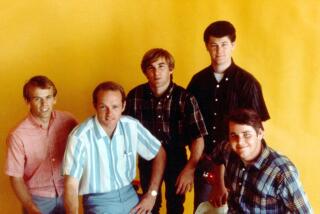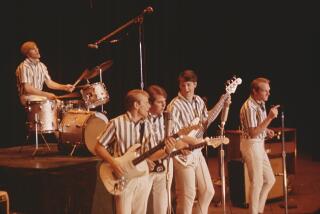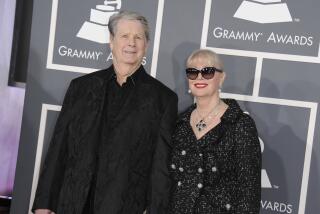‘Becoming the Beach Boys’ 2-CD set explores the group’s earliest efforts
- Share via
Putting a fledgling band under the microscope by examining every moment of its earliest work generally falls under the same bit of wisdom often applied to brain surgery, sausage-making and journalism: important activities in the grand scheme of things, but not processes you typically want to zero in on.
For the most important and influential artists, however, it can be extremely illuminating, which is why studio outtakes, false starts and other recorded minutiae from the likes of Elvis Presley, the Beatles, Aretha Franklin, Bruce Springsteen or Eminem, for instance, can be fully worthy subjects for such archival releases.
For the record:
8:19 p.m. Jan. 26, 2025An earlier version of this post identified Al Jardine as a cousin of the Wilson brothers. He was a family friend. Singer Mike Love is the Wilsons’ cousin.
That’s the idea behind “Becoming the Beach Boys: The Complete Hite & Dorinda Morgan Sessions,” a two-CD set that was released Aug. 26 by the artisan-style archival label Omnivore Recordings, which specializes in bringing valuable material to light that’s never previously been available.
Over the course of its 63 tracks (more than 40 of which have never seen the light of day), “Becoming the Beach Boys” documents the quintessential Southern California fun-in-the-sun band at its birth. The collection allows super fans to hear demo versions, working takes, snippets of takes and final masters created in 1961 and 1962, well before Capitol Records signed and helped catapult to fame the group consisting of Brian Wilson, Mike Love, Carl Wilson, Dennis Wilson and Alan Jardine.
See the most-read stories in Entertainment this hour »
Those 63 tracks, some as brief as 20 seconds, most running two minutes or under, as was common in the early ’60s, explore the genesis of nine songs, from such future Beach boys classics as “Surfin’ Safari” and “Surfer Girl” to curiosities including “Luau,” “Judy,” “Barbie” and “Lavender.”
These sessions are strikingly different than, say, the Sun Studio sessions Jerry Lee Lewis laid down in the 1950s recently released in their unvarnished entirety in the 18-CD Bear Family label box set: “Jerry Lee Lewis at Sun Records: The Collected Works.”
Where Lewis was a musical shooting star who took many of his songs through wildly different interpretations and arrangements en route to finding those that clicked for eventual release by Sun owner Sam Phillips, the Beach Boys here largely repeat already established arrangements time after time primarily in search of the finest performance.
Studio owner and producer Hite Morgan’s approach to recording was fairly basic, focusing on live-in-the-studio performances with minimal overdubs.
Indeed, at the end of Take 6 of “Surfer Girl,” we hear 19-year-old Brian Wilson asking to overdub his bass part later so he can focus instead on his lead vocal, only to be given a sharp “No!” in response.
Because such largely forgettable songs as “Luau,” “Judy” and the instrumental “Beach Boy Stomp” are little more than basic three-chord rock workouts, listening to a half-dozen run-throughs will be of only fleeting interest to the average music fan, although they may yield some moments of interests for the die-hard Beach Boys/Brian Wilson students.
For example, in “Judy” (which is given the strange doo-wop syllabic expansion of “Judy-papa-Judy” as a vocal background), the succeeding takes hear 15-year-old Carl Wilson become more assertive in his Chuck Berry-influenced lead guitar work as the sessions unfolds.
Brian Wilson’s gorgeous stratospheric lead vocal on that song puts the spotlight on what from the start was a crucial part of the group’s signature sound. The turnaround into the resolving chord progression in “Luau” also sounds like the melodic template Brian Wilson and Mike Love adopted later when they wrote “Little Honda,” where they exhort a date to “put on a ragged sweatshirt / I’ll take you anywhere you want me to.”
“Lavender,” written by Hite Morgan’s wife and business partner Dorinda Morgan, provides a thrilling sample of just how accomplished the Beach Boys were as singers even at this early stage. The multi-part harmonies are spot-on and demonstrate the deep influence the Four Freshmen jazz-pop vocal group had on Brian Wilson’s approach to complex harmonic structure.
The set credits two of the tracks — “Barbie” and “What Is a Young Girl Made Of” — to Kenny and the Cadets, a side project that featured Brian and Carl Wilson, Jardine, plus the family matriarch Audree Wilson and friend Val Poliuto as the fifth member of the vocal quintet.
The treat here is listening in on the two Wilson boys blend voices with their mother, along with Jardine and Poliuto. “Barbie,” strongly rooted in ’50s R&B and, yes, inspired by the Mattel fashion-conscious doll that became an icon of the era, bears a striking resemblance musically to Brian’s own “Surfer Girl” and further gives full run to his wondrously pliant voice.
Ultimately, this set will be of greatest interest to those pure pop fans yearning to pore over every growth spurt experienced by these five musicians en route to becoming America’s biggest rock band of the 1960s.
Follow @RandyLewis2 on Twitter.com
For Classic Rock coverage, join us on Facebook
ALSO
What would Brian Wilson change about ‘Pet Sounds’? He reflects 50 years later
Politics and pop music: Will frequent adversaries ever come together?
More to Read
The biggest entertainment stories
Get our big stories about Hollywood, film, television, music, arts, culture and more right in your inbox as soon as they publish.
You may occasionally receive promotional content from the Los Angeles Times.










